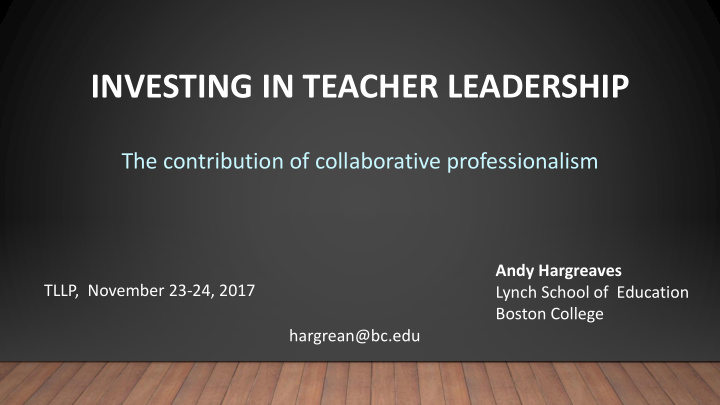



INVESTING IN TEACHER LEADERSHIP The contribution of collaborative professionalism Andy Hargreaves TLLP, November 23-24, 2017 Lynch School of Education Boston College hargrean@bc.edu
1. Human Capital 2. Decisional Capital 3. Social Capital
Why should we collaborate? How should we collaborate? What are different ways to collaborate that have value?
For the most part, the Commodore on the quarterdeck gets his atmosphere at second hand from the sailors on the forecastle. He thinks he breathes it first; but not so. In much the same way do the commonality lead their leaders in many other things, at the same time that the leaders little suspect it. 5
Five Phases of Collaboration Absence…… teachers work by themselves Emergence… research shows benefits of collaboration Doubt……….. some collaboration is weak or forced Design……… models & protocols for collaboration are made Opposition… collaboration is criticized for being ineffective Transformation… movement to collaborative professionalism
Professional development & collaboration are: • Expensive • Ineffective • A waste of money
Professional Collaboration
Collaborative Professionalism
1. To articulate the theory of action of the CODE Consortium’s Leading from the Middle projects. 2. To gather perceptions of the projects’ strengths and limitations, impacts and effectiveness 3. To connect findings to evidence of other leadership models. 4. To share the interim and final results internally and externally to forge new forms of collaborative professionalism.
Collaborative Professionalism in Ontario is defined as professionals … working together, sharing knowledge, skills and experience to improve student achievement, and the well-being of both students and staff. Collaborative Professionalism values the voices of all and reflects an approach in support of our shared responsibility to provide equitable access to learning for all. All staff are valued and have a shared responsibility as they contribute to collaborative learning cultures. Ontario Ministry of Education (2016). Collaborative professionalism (Policy/Program Memorandum No. 159). Toronto, Ontario: Author.
Collective Autonomy Collective Efficacy Collaborative Inquiry Collective Responsibility Collective Initiative Mutual Dialogue & Feedback Joint Work Common Meaning & Purpose Collaborating with Students Owning the Big Picture
Collaborative Professionalism is not about.. * interminable meetings * other people’s mandates * racing cycles of data analysis/intervention * only sharing & learning * collaborating against other schools
Collaborative professionalism is about how teachers & other educators transform teaching & learning together to work with all students to develop fulfilling lives of meaning, purpose, & success.
Collaborative Professionalism is organized in an evidence-informed, but not data-driven, way through rigorous planning, deep & sometimes demanding dialogue, candid but constructive feedback, & continuous collaborative inquiry.
Collaborative Professionalism is embedded in the culture & life of the school, where educators actively care for & have solidarity with each other as fellow-professionals as they pursue their challenging work together in response to the cultures of their students, the society & themselves
Collaborative Designs
Open Class
What are do you see here about * teacher leadership? * professional learning? * vulnerability? * responsibility?
WRITING ON THE IBOARD
ENGLISH: STUDENTS SHARING
SHARING RATIONALE IN POST LESSON CONFERENCE
ENGLISH OPEN CLASS: LOTS OF VISITORS
SO MANY VISITORS: BUT THE STUDENTS ARE STILL WORKING
FINAL PRODUCT FROM POST OPEN CLASS CONFERENCE!
Collaborative Pedagogical Transformation
ESCUELA NUEVA
What are do you see here about… * relationship between pupil & teacher learning and leadership? * spreading leadership & learning? * the ends of leadership & learning?
Professional Learning Communities
What are do you see here about… * teacher & principal leadership & learning? * professional culture and local culture?
INDIGENEITY Seven Sacred Grandfather Teachings
Indigeneity
Collaborative Planning Networks
What are do you see here about… * collaboration in rural environments? * professional networks?
THE NW RISE NETWORK FOCUS Community Social Attachment (Network) (Quality of life) Empowerment Decisional Student (Learning to learn, Professional Capital Engagement learning to lead, (Coaching) learning for life) Human Achievement (Equity/Quality) (Skills)
NW RISE NETWORK DESIGN PROCESS Concept Development Evaluation Committee Steering Theme Network Membership Implementation Design Elements Design Team Network Architecture Work Literature Reference Review Groups
NETWORKS Shared goals Site selection/recruitment Activities Focus Leadership and steering Resources Citizenship Dissemination
Cooperative Learning and Teaching
The Four Bs
Collaborative professionalism is about how teachers & other educators transform teaching & learning together to work with all students to develop fulfilling lives of meaning, purpose, & success.
Collaborative Professionalism is organized in an evidence-informed, but not data-driven, way through rigorous planning, deep & sometimes demanding dialogue, candid but constructive feedback, & continuous collaborative inquiry.
Collaborative Professionalism is embedded in the culture & life of the school, where educators actively care for & have solidarity with each other as fellow-professionals as they pursue their challenging work together in response to the cultures of their students, the society & themselves
Coming to a school near you
Recommend
More recommend